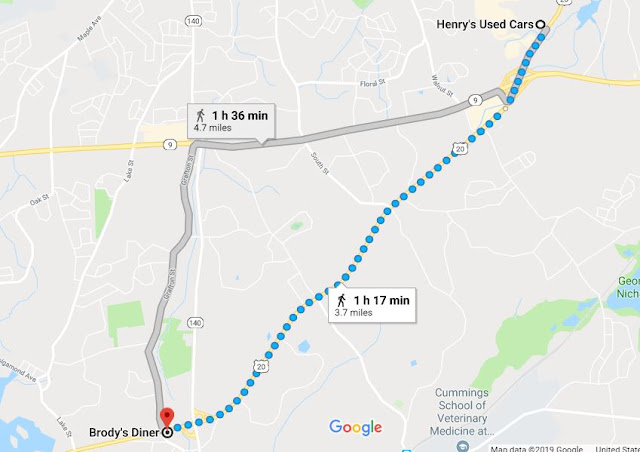 |
| 100 Worcester Rd to Sturbridge Coffee House |
Today's report takes me seven miles through Charlton to Sturbridge, Massachusetts. My first goal is reached!
For the most part this trek took me past many businesses and some very old houses, most of which are not considered especially historical by realtors. For instance, there is this house (pictured below) at 19 Sturbridge Rd that was built in 1810. Quite beautiful, no? But not on any list of historical sites.
 |
| 19 Sturbridge Rd, Charlton |
And there is this house just off Highway 20 at 5 Carpenter Hill Rd in Charlton that was built in 1790.
 |
| 5 Carpenter Hill Rd, Charlton |
Massachusetts seems kind of blase about such old houses, unlike more recently settled states (such as Michigan).
Among the normal chain restaurants, industrial retailers, car dealerships, quick-stop stores and gas stations were a few businesses that caught my eye. One was
Fabric Stash, a quilt store at 45 Sturbridge Rd, Charlton. It seemed like a typical quilt store, but it was nice to see it there as a local business.
Once I got into Sturbridge, I spotted
Mole Hollow Candles. Though it sounds like an ordinary candle store, it's in fact not ordinary because they actually make the candles they sell there: Mole Hollow Candles, at 208 Charlton Rd, Sturbridge. And they make a lot of candles! Below is a photo of their building--yes, it's a factory.
 |
| Mole Hollow Candles |
But lest you think they are like any other factory, I've copied the story of their beginnings from their website, below. I can picture these candle makers in 1969 selling their wares at farmers markets, can't you?
Mole Hollow Candles was founded in western Massachusetts in 1969. We began by selling candles at farmers markets, and slowly scaled up to a national presence. Today, Mole Hollow Candles can be found throughout the country at independent retailers, gourmet stores, Bloomingdale's, and Whole Foods Markets.
Quite a lot has changed since 1969, but some things - like our process and our materials - never will. We maintain the utmost commitment to quality, artisan manufacturing with a focus on domestically sourced waxes, wicks, and scents. We employ local craftspeople and all of our products remain made in Massachusetts.
Of course, passing through Sturbridge means passing by the famous historic site,
Old Sturbridge Village, one of the many historic villages in the country, and the largest in New England. It's designed to recreate a village in 1830s Massachusetts. Since it is not located on US-20, I won't be visiting today, but I do have a memory of visiting it back in 1969 and enjoying it very much!
 |
| North Cemetery |
The second oldest cemetery in Sturbridge, North Cemetery, lies along US-20, though you can't see it from the road.
Below is a plaque that was erected at the cemetery describing its historical significance.
 |
North Cemetery Information |
Well, I've finally made it to my destination today, the Sturbridge Coffee House, where I plan to take a break and have some coffee. It's a very appealing place!
 |
| Sturbridge Coffee House |
 |
| Sturbridge Coffee House |




















































